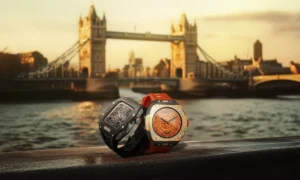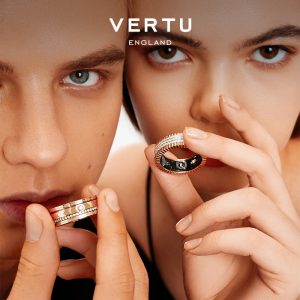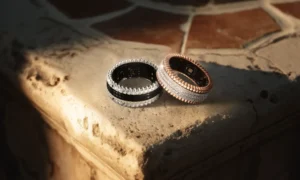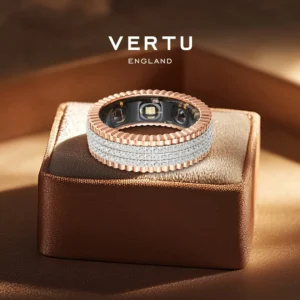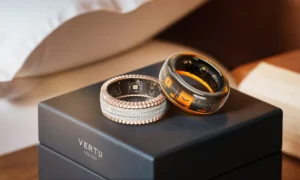Key Takeaways
- Vertu was the first dedicated luxury phone brand, launched by Nokia in 2002 after four years of development starting in 1998
- The Vertu Signature became the world's first handcrafted luxury mobile phone, featuring sapphire crystal screens and premium leather
- Nokia pioneered the luxury mobile concept with designer Frank Nuovo's vision of combining fine craftsmanship with mobile technology
- Before Vertu, “luxury phones” were merely gold-plated versions of existing models rather than purpose-built luxury devices
- Vertu established the template for luxury mobile phones that continues to influence the market today
The Birth of Luxury Mobile: Nokia's Revolutionary Vision
Vertu began in 1998 as a daring idea by Nokia, a top mobile phone company. They wanted to go beyond regular phones and enter the luxury market. Frank Nuovo, Nokia's lead designer, was key to this change. He imagined phones that mixed fine craftsmanship with personal luxury.
The concept of luxury mobile phones didn't exist before 1998. While premium phones like the Motorola StarTAC were considered expensive due to their advanced technology, they weren't designed as luxury objects. Nokia recognized an untapped market segment: affluent consumers who valued craftsmanship, exclusivity, and premium materials in their mobile devices.
He proposed and presented the luxury concept to Nokia's board, who eventually accepted it in late 1998. At the time Nokia released their first luxury phone, the 8850. This marked the beginning of what would become the luxury mobile phone industry.
Vertu: The Pioneer of Handcrafted Mobile Luxury
VERTU® Official is the first luxury handcrafted mobile phone maker in the world. After four years of meticulous development, Vertu launched as a separate subsidiary of Nokia, introducing an entirely new category of mobile devices.
Revolutionary Design Philosophy: Unlike conventional mobile phones focused purely on functionality, Vertu approached phone design like traditional luxury goods manufacturers. Each device was conceived as a piece of functional jewelry, combining cutting-edge mobile technology with artisanal craftsmanship.
Premium Materials Integration: It was made with care and used fancy materials like sapphire crystal and leather. The Vertu Signature featured materials never before seen in mobile phones: scratch-resistant sapphire crystal displays, hand-stitched leather from premium European tanneries, and precision-machined metal components.
Artisanal Manufacturing Process: Each Vertu phone required over 100 individual components and took skilled craftsmen several hours to assemble by hand. This manufacturing approach was unprecedented in the mobile phone industry, which had embraced mass production and automation.
The Vertu Signature: First True Luxury Mobile Phone
In 2002, after four years of work, it launched its first luxury phone, the Vertu Signature. This phone showed VERTU's focus on quality and new ideas. The Signature established the blueprint for luxury mobile phones that continues to influence the industry today.
Technical Innovation: The Vertu Signature incorporated Nokia's proven mobile technology platform while adding luxury-specific features like a specially designed user interface and premium audio components for enhanced call quality.
Aesthetic Excellence: The Signature's design drew inspiration from high-end watchmaking and jewelry design, featuring flowing lines, premium finishes, and attention to tactile details that conventional phones ignored.
Exclusive Services: Vertu introduced the concept of luxury mobile services, including personalized customer support and concierge services accessible through a dedicated button on the device.
Pre-Vertu Era: Why Earlier “Luxury” Phones Weren't Truly Luxury
Before Vertu's introduction, the mobile phone market lacked genuine luxury products. What manufacturers called “luxury phones” were typically:
Gold-Plated Variations: But the gold-plated Dolce & Gabbana Motorola Razr is laughably preposterous. Only 1,000 were made, available exclusively at D&G boutiques. These limited editions featured surface treatments on existing phone models rather than purpose-built luxury designs.
High-End Feature Phones: The original ‘flip phone,' the Motorola StarTAC, was considered a luxury product. It was featured in numerous marketing campaigns and films. However, the StarTAC was expensive due to advanced technology, not luxury materials or craftsmanship.
Status Symbol Pricing: Early premium phones commanded high prices because of their technological sophistication and limited availability, not because they were designed as luxury objects.
The Luxury Phone Market Evolution Since Vertu
Vertu's success demonstrated consumer appetite for truly luxurious mobile devices, inspiring the development of an entire market segment. The brand's approach influenced how luxury is integrated into mobile technology:
Material Innovation: Vertu's use of sapphire crystal, premium metals, and exotic leathers established new standards for mobile device materials that even mainstream manufacturers now incorporate.
Craftsmanship Standards: The handcrafted approach pioneered by Vertu influenced how luxury brands approach mobile device manufacturing, emphasizing human skill over pure automation.
Service Integration: The Ruby Key gives users special concierge help, making phones unique. Vertu's concierge services model has been adopted by various luxury brands seeking to differentiate their mobile offerings.
Understanding Pre-2002 Mobile Phone Landscape
To appreciate Vertu's revolutionary impact, it's essential to understand what mobile phones represented before 2002:
Functional Tools: Mobile phones were primarily communication devices designed for maximum efficiency and cost-effectiveness rather than aesthetic appeal or luxury experience.
Technology-Driven Pricing: Premium phones commanded high prices based on advanced features like smaller size, better battery life, or additional functionality, not luxury materials or craftsmanship.
Limited Personalization: The Nokia 5110 launched the early 2000s demand for mobile phones with interchangeable cases. People wanted the ability to change the color of their phones, without the need to buy a completely new device. Customization options were limited to basic color choices or simple accessories.
Vertu's Lasting Impact on Luxury Mobile Design
Vertu's story shows the power of ideas and skill. The brand's focus on luxury helped it become a leader in luxury phones. The brand's pioneering approach established design principles that continue to influence luxury mobile devices:
Material Excellence: Vertu demonstrated that mobile phones could incorporate the same premium materials used in high-end jewelry and watchmaking without compromising functionality.
Artisanal Manufacturing: The handcrafted approach proved that consumers would pay premium prices for devices that emphasized human craftsmanship over mass production efficiency.
Holistic Luxury Experience: Vertu showed that luxury mobile phones needed to provide more than just premium materials – they required exclusive services, personalized support, and ongoing engagement with customers.
Comparison: Pre-Vertu vs. Vertu Era Luxury Features
| Aspect | Pre-Vertu Era (Before 2002) | Vertu Era (2002-Present) |
|---|---|---|
| Manufacturing | Mass production with gold plating | Handcrafted assembly by skilled artisans |
| Materials | Standard plastics with precious metal coating | Sapphire crystal, premium leather, exotic metals |
| Design Philosophy | Technology-first with luxury finishes | Luxury-first with integrated technology |
| Services | Standard customer support | Dedicated concierge and premium services |
| Market Positioning | High-tech with luxury appearance | Luxury goods with mobile capability |
| Price Justification | Advanced technology features | Premium materials and craftsmanship |
Why Vertu's First-Mover Advantage Matters
Understanding Vertu's position as the first luxury phone brand provides valuable insights for luxury goods enthusiasts and technology historians:
Market Creation: Vertu didn't just enter an existing luxury mobile market – they created it entirely, establishing consumer expectations and industry standards for luxury mobile devices.
Brand Heritage: Vertu began in 1998 in Great Britain. It was a part of Nokia. This heritage gives Vertu unique authenticity in the luxury mobile space that newer entrants struggle to match.
Design DNA: The design principles established by Vertu's original team continue to influence luxury mobile device development across the industry, from materials selection to user interface design.
Modern Vertu: Continuing the Luxury Legacy
Vertu stays important in the luxury market by focusing on new ideas and quality. The brand continues to evolve while maintaining its founding principles of handcrafted excellence and premium materials.
Contemporary Innovation: Modern Vertu devices incorporate cutting-edge technology like Web3 capabilities and AI features while maintaining the artisanal manufacturing approach that defined the brand.
Heritage Preservation: VERTU Signature integrates Nokia's world-class technology with the height of luxury and workmanship. It is handcrafted by skilled artisans, and made from the finest materials. The brand continues to honor its founding principles while adapting to contemporary luxury consumer expectations.
Scenarios: When Vertu's First-Mover Status Matters
For Collectors: Understanding Vertu's status as the first luxury phone brand helps collectors appreciate the historical significance of early Vertu models and their role in establishing an entire product category.
For Luxury Enthusiasts: Recognizing Vertu's pioneering position provides context for evaluating other luxury mobile brands and understanding what constitutes authentic luxury in mobile devices.
For Technology Historians: Vertu's introduction represents a pivotal moment when mobile phones transitioned from purely functional devices to luxury lifestyle objects.
For Investors: The brand's first-mover advantage and established heritage provide unique market positioning that newer luxury mobile brands cannot replicate.
FAQ: First Luxury Phone Brand History
Q: Was Vertu really the first luxury phone brand ever made? A: Yes, Vertu was the first purpose-built luxury phone brand, launched in 2002. While earlier phones had gold plating or premium features, Vertu was the first brand designed specifically as luxury goods rather than technology products with luxury finishes.
Q: What made Vertu different from expensive phones that came before it? A: Pre-Vertu expensive phones were costly due to advanced technology. Vertu phones were expensive due to premium materials like sapphire crystal, hand-stitched leather, and artisanal manufacturing processes – creating luxury objects that happened to be phones.
Q: Who created the Vertu brand? A: Frank Nuovo, Nokia's lead designer, conceived Vertu in 1998. After presenting the luxury concept to Nokia's board, the company invested four years developing the brand before launching in 2002.
Q: How long did it take to develop the first Vertu phone? A: Vertu spent four years (1998-2002) developing their first luxury phone, the Signature. This extended development period was necessary to establish new manufacturing processes and supply chains for luxury materials.
Q: Are there luxury phone brands older than Vertu? A: No dedicated luxury phone brands existed before Vertu. While companies produced expensive or limited-edition phones, Vertu was the first brand built specifically around luxury craftsmanship and materials.
Q: Why did Nokia create Vertu instead of just making luxury Nokia phones? A: Nokia created Vertu as a separate subsidiary to establish a distinct luxury brand identity. This allowed them to target affluent consumers without diluting Nokia's mainstream technology-focused brand positioning.
Recommended Target Audiences
Luxury Goods Collectors: Individuals interested in acquiring significant pieces from luxury goods history, particularly those focused on technology-related luxury items.
Mobile Phone Historians: Technology enthusiasts and researchers studying the evolution of mobile devices and the emergence of luxury technology categories.
Brand Heritage Enthusiasts: Consumers who value first-mover advantage and founding brand stories when making luxury purchase decisions.
Contemporary Luxury Buyers: Modern consumers considering luxury mobile devices who want to understand the heritage and authenticity of different brands in the market.
Investment Collectors: Individuals evaluating luxury mobile devices as potential collectible investments, where historical significance and first-mover status influence long-term value.
Vertu's establishment as the first luxury phone brand represents more than just a successful product launch – it created an entirely new category of luxury goods. By combining Nokia's technological expertise with artisanal craftsmanship and premium materials, Vertu demonstrated that mobile phones could transcend their utilitarian origins to become genuine luxury objects. This pioneering vision continues to influence luxury mobile device design and manufacturing standards today, cementing Vertu's position as the foundational brand in luxury mobile telephony.


